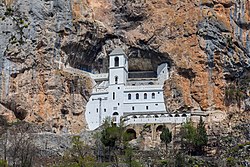Central Montenegro
Central Montenegro | |
|---|---|
 Central Montenegro | |
| Country | Montenegro |
| Largest city | Podgorica |
| Municipalities | |
| Area | |
• Total | 4,917 km2 (1,898 sq mi) |
| Population | |
• Total | 307,371 |
| • Density | 63/km2 (160/sq mi) |
| Time zone | UTC+1 (CET) |
| • Summer (DST) | UTC+2 (CEST) |
| HDI | 0.853 (2022)[4] very high · 1st |
Central Montenegro is one of three statistical regions in Montenegro. It comprises the central regions of the country, including the capital city of Podgorica and the historic capital city of Cetinje. Spread over an area of 4,917 km2 (1,898 sq mi), the region incorporates six municipalities. It is sandwiched between the other two regions of Montenegro (Northern and Coastal) and shares international land borders with Bosnia and Herzegovina in the northwest, and Albania in the southeast. The region had a population of just over 0.3 million in 2024, making it the most populous statistical region in the country.
History
[edit]The region was under the control of Ottoman Empire in the late Middle Ages. It became part of the independent kingdom of Montenegro from 1910 to 1918 with the capital at Cetinje. It became part of Yugoslavia in 1929.[5] The capital was moved to Podgorica in 1946.[6] It became part of Serbia and Montenegro in 1991 after the dissolution of Yugoslavia. The region became part of the independent country of Montenegro in 2006.[5]
In 2007, following the adoption of the Constitution of Montenegro, the municipalities were established along with the capital city of Podgorica and the historic capital city of Cetinje.[5] In 2011, the Central region was establishes as one of the three statistical regions by the Regional Developmental Law enacted by the Parliament of Montenegro.[7] The central region consisted of Podgorica, Cetinje, the municipalities of Danilovgrad, and Nikšić, and the urban areas of Tuzi and Golubovci.[8] Tuzi Municipality was carved from the capital territory in 2018.[8][9] In 2022, Zeta Municipality was established from the territory surrounding Golubovci.[10]
Administration
[edit]Montenegro is divided into three statistical regions–Northern, Central, and Coastal. These regions do not have any administrative functions and serve for statistical purposes only.[11] For local administration, the country is divided into 25 municipalities including the capital city of Podgorica and the historic capital city of Cetinje.[8][12]
The central region incorporates six municipalities–Cetinje, Danilovgrad, Nikšić, Podgorica, Tuzi, and Zeta. These municipalities have their own regional councils.[13]
| Municipality | Code | Native Name | Capital | Area (km2) | Population (2023) |
|---|---|---|---|---|---|
| Cetinje | CET | Цетиње | Cetinje | 910 | 14,494 |
| Danilovgrad | DAN | Даниловград | Danilovgrad | 501 | 18,617 |
| Nikšić | NIK | Никшић | Nikšić | 2,065 | 65,705 |
| Podgorica | POD | Подгорица | Podgorica | 1,047 | 179,505 |
| Tuzi | TUZ | Тузи | Tuzi | 242 | 12,979 |
| Zeta | ZET | Зета | Golubovci | 152 | 16,071 |
Geography
[edit]Spread over an area of 4,917 km2 (1,898 sq mi), the region incorporates the central areas of the country.[1] It is sandwiched between the other two regions of Montenegro (Northern and Coastal) and shares international land borders with Bosnia and Herzegovina in the northwest, and Albania in the southeast.[15] The region is located close to the coast of the Adriatic Sea, and experiences a typical Mediterranean climate.[15] The region consists of the Skadar Lake, shared with Albania.[16]
Demographics
[edit]The region had a population of just over 0.3 million in 2024, making it the most populous statistical region in the country.[3] Nearly half of the population of the country resided in the region, with the capital region of Podgorica home to nearly 180,000 people.[2][8] Montenegrin people formed the major ethnicity in five of the six municipalities in the region, with Serbian being the most spoken language. Albanians, who spoke Albania, formed the majority in Tuzi.[14] With a high HDI, the region is the most developed in the country.[4]
References
[edit]- ^ a b c "Statistical regions" (PDF). Statistical office of Montenegro. p. 6. Retrieved 1 June 2024.
- ^ a b "Cities of Montenegro". Citypopulation.de. Retrieved 1 June 2024.
- ^ a b "Census 2023: Population by gender and age" (PDF). Statistical office of Montenegro. p. 2. Retrieved 1 June 2024.
- ^ a b "Sub-national HDI - Area Database - Global Data Lab". Global datalab. Retrieved 1 June 2018.
- ^ a b c "Regionalisation in Montenegro: not regions, but municipalities". European Union. Retrieved 1 June 2024.
- ^ "Montenegro". Statoids. Retrieved 1 June 2024.
- ^ "Regional Developmental Law". Parliament of Montenegro. Retrieved 1 June 2024.
- ^ a b c d "Montenegro: country profile". World Observatory on subnational government and finances. Retrieved 1 June 2024.
- ^ "Tuzi will become independent municipality". CDM. Retrieved 1 June 2024.
- ^ "Zeta becomes a municipality from today". CDM. 23 August 2022. Retrieved 1 June 2024.
- ^ "Montengetro: Responses to disasters and crises through subnational protection systems" (PDF). UNICEF. Retrieved 1 June 2024.
- ^ "Division powers". European Union. Retrieved 1 June 2024.
- ^ "Regional mandate" (PDF). Government of Montenegro. Retrieved 1 June 2024.
- ^ a b "Population of Montenegro according to national or ethnic affiliation, religion, native language and language usually spoken" (PDF). Statistics office of Montenegro. Retrieved 1 June 2024.
- ^ a b Nevena Mašanović; Nenad Lipovac; Marija Jevrić (2021). "Montenegrin Rural Settlement Attributes, Problems, and Possibilities for Development According to Their Regional Affiliation". Journal on architecture and urban planning. 29: 130–141. doi:10.31522/p.29.1(61).10.
- ^ "Central region". Rural holiday. Retrieved 1 June 2024.






